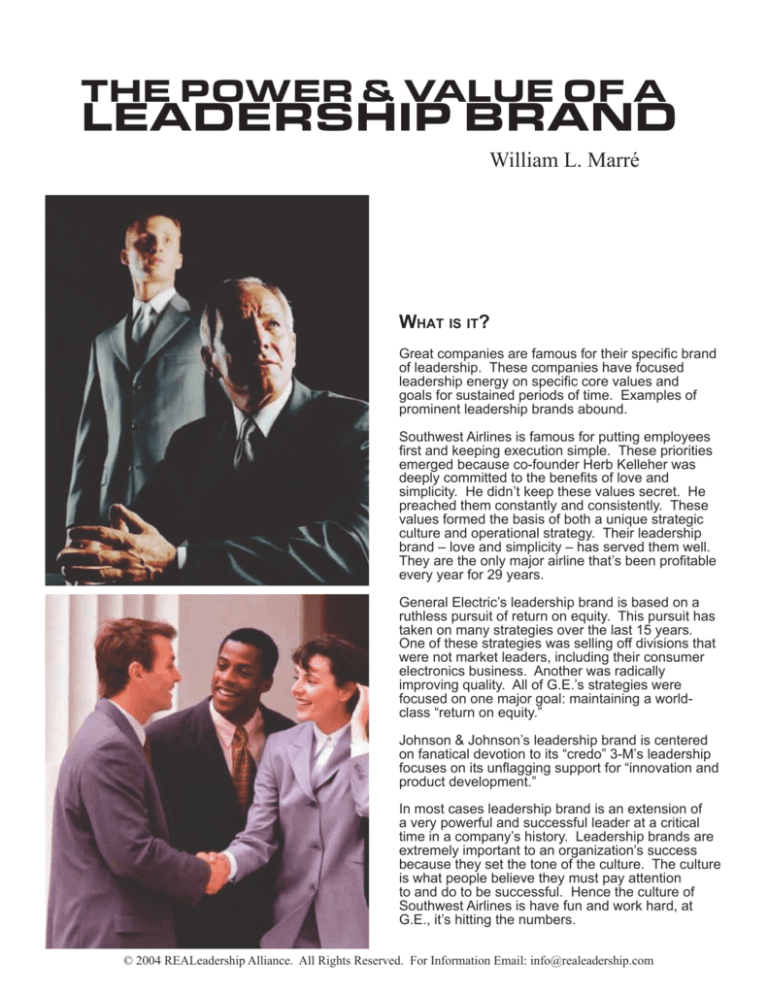
THE POWER & VALUE OF A
LEADERSHIP BRAND
William L. Marré
WHAT IS IT?
Great companies are famous for their specific brand
of leadership. These companies have focused
leadership energy on specific core values and
goals for sustained periods of time. Examples of
prominent leadership brands abound.
Southwest Airlines is famous for putting employees
first and keeping execution simple. These priorities
emerged because co-founder Herb Kelleher was
deeply committed to the benefits of love and
simplicity. He didn’t keep these values secret. He
preached them constantly and consistently. These
values formed the basis of both a unique strategic
culture and operational strategy. Their leadership
brand – love and simplicity – has served them well.
They are the only major airline that’s been profitable
every year for 29 years.
General Electric’s leadership brand is based on a
ruthless pursuit of return on equity. This pursuit has
taken on many strategies over the last 15 years.
One of these strategies was selling off divisions that
were not market leaders, including their consumer
electronics business. Another was radically
improving quality. All of G.E.’s strategies were
focused on one major goal: maintaining a worldclass “return on equity.”
Johnson & Johnson’s leadership brand is centered
on fanatical devotion to its “credo” 3-M’s leadership
focuses on its unflagging support for “innovation and
product development.”
In most cases leadership brand is an extension of
a very powerful and successful leader at a critical
time in a company’s history. Leadership brands are
extremely important to an organization’s success
because they set the tone of the culture. The culture
is what people believe they must pay attention
to and do to be successful. Hence the culture of
Southwest Airlines is have fun and work hard, at
G.E., it’s hitting the numbers.
© 2004 REALeadership Alliance. All Rights Reserved. For Information Email: info@realeadership.com
THE VALUE OF A LEADERSHIP BRAND
The concept of a leadership brand has come even
more important recently, because Wall Street
has started to pay attention. It is no surprise that
companies that have consistently good financial
results typically have strong leadership brands.
More and more Wall Street analysts are investing in
management. They, too, understand that strategies
may change, technology may come and go, shortterm competitive advantages ebb and flow. But
smart leadership wins. Wall Street also seems to
take comfort in knowing that a leadership brand
almost always ensures that leadership succession
will honor the brand and continue the leadership
strategy that has led to success.
Perhaps nowhere is the value of excellent leadership
more highly prized than by venture capitalists who
will invest millions with the right leadership team.
The business idea is secondary. The right team will
change the idea to fit the ever-emerging changes
in the economy. Venture capitalists understand the
value of developing a leadership brand arising from
the power and discipline of a focused leadership
team.
Until recently, leadership brands emerged
serendipitously. Now, however, organizations are
seeing it as a key competitive advantage. Not only
does leadership that stands for something bring
about business success, it also helps support stock
price in bad times, and it increases the multiple in
good times.
HOW TO BUILD A LEADERSHIP BRAND
Building a leadership brand begins first with
identifying if there are latent strategic values in
the organization that are already being lived and
inherited from past effective leaders. If there is a
history of strong, successful leadership the values
that drove that leadership need to be identified and
communicated. If an organization is new, or there
isn’t a particularly strong set of leadership values
that have been a source of decision making, then
values need to be chosen.
The best leadership brands stand for one or two
ideas. They need to be very focused and absolutely
strategic. What are the key values that will make a
difference in the marketplace – to the customer, to
investors and to employees? Once those values
are identified, the brand needs to be communicated
both internally and externally. The brand can be
communicated through leadership development,
training, speeches, electronic communication, and
other forms of internal and external messages. The
brand also needs to be lived. Senior management,
especially, must be committed to the brand and need
to understand how those values are implemented,
modeled and rewarded day in and day out.
Instituting a leadership brand involves four simple
things: (1) communication; (2) education (3)
modeling; and (4) rewarding. Often the channels
to create a leadership brand are in different parts
of the organization. All of those elements need to
be coordinated. Marketing, advertising, internal
communications, training and development,
executive behavior and the reward system all need
to be aligned to deliver one message – that living
strategic leadership values will create the results the
organization is after.
There is ample evidence that when leaders are very
clear on what strategic leadership values are most
important to them, those values create the culture.
The culture drives behavior, and behavior drives
results. Leadership brands are important. Without
a strong leadership brand, an organization will likely
suffer from underperformance and will, therefore, be
undervalued.
So, what is your leadership brand? If three of your
senior executives cannot come up with the same
answer in 90 seconds, it is safe to say you probably
don’t have one. If you do have a successful
leadership brand, build it. Amplify it. Wring the
value of it. Communicate it explicitly. Make sure
all of management and all employees make their
daily decisions based on your strategic values and
priorities – your leadership brand. Communicate,
educate, model and reward. These are the
leadership disciplines that build brands.
If you don’t have a leadership brand, look at the
specific behavior that drives your organizations’
success. What strategic values are being expressed
when you win? What behaviors are critical to
consistently meeting the demands and desires of
your customers, investors and employees?
Once you identify core, enduring strategic values,
your organization needs to focus on to sustain
success, exercise the leadership discipline to build
your own leadership brand. Building a leadership
brand is not trivial. In a rapidly changing world,
leadership brand may be the most important
competitive advantage of the future.
© 2004 REALeadership Alliance. All Rights Reserved. For Information Email: info@realeadership.com








